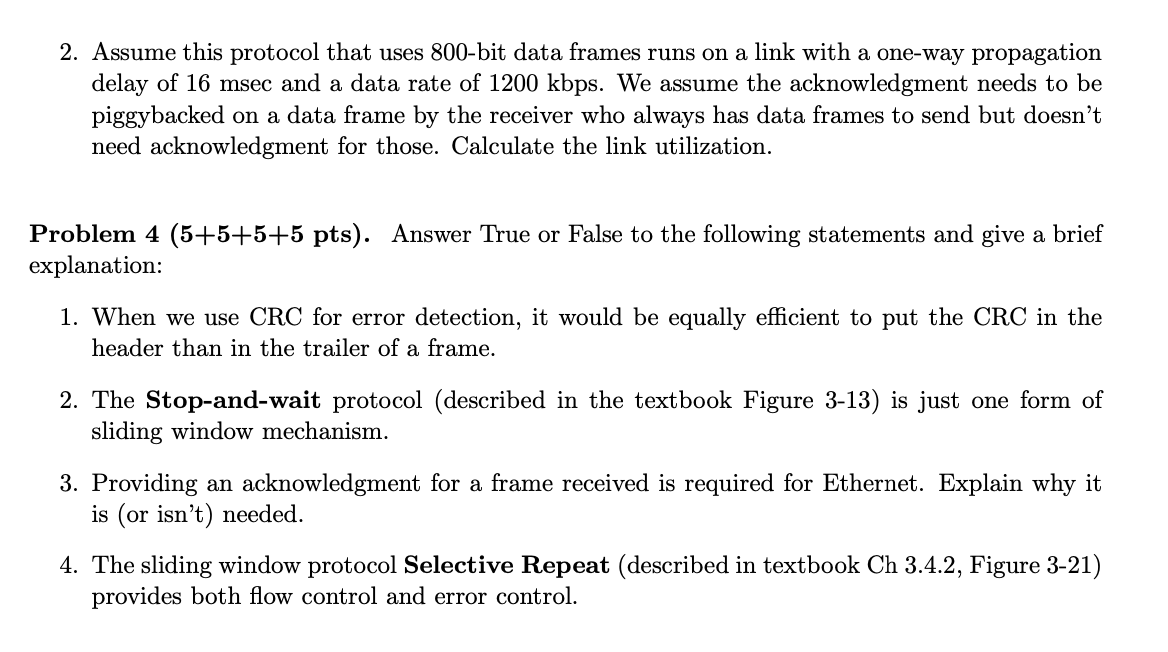Answer ALL the questions please. I will provide a good rating.


Problem 1 (5+5 pts). Flag bytes with byte stuffing and flag bits with bit stuffing are two methods of breaking up a bit stream into frames (read textbook Ch 3.1.2 on Framing). Answer the following questions: 1. The following frame (a byte stream) is received at the data link layer and we know that the byte-stuffing algorithm described in our textbook has been used: What is the output after destuffing? 2. The following data fragment (a bit stream) is received at the data link layer and we know that the bit-stuffing algorithm described in our textbook has been used: 011001111100111101111101 What is the output after destuffing? (use a space every 4 bits, just like the stuffed one above) Problem 2 (5+5 pts). Hamming codes (textbook Ch 3.2.1) can be used for error correction or detection. Answer the following questions: 1. For the (11,7) Hamming code described in the textbook (Figure 3-6), can it be used to do error correction and error detection at the same time (i.e., correct one error, detecting another)? 2. Consider a protocol that for every 16 bytes of message data adds 1 byte of redundant data. Can this protocol use a Hamming code to correct single errors? (*hint: refer to Equation (3-1) in Ch 3.2.1) Problem 3 (5+5 pts). A stop-and-wait protocol (read textbook Ch 3.3.3) is a simple data link layer for flow control, in which the sender sends one data frame and then waits for an acknowledgment frame from the receiver before sending the next data frame. We define link utilization U as: U:=TtotalTtrans where Ttrans is the sender's transmission time for the frame and Ttotal is the duration from the sender starting transmission to receiving the acknowledgment frame. Answer the following questions: 1. Assume this protocol achieves 20% link utilization using 1500 -bit data frames over a link with a one-way propagation delay of 50msec. We ignore the transmission time for the acknowledgment frame. What is the data rate of this link in bits per second? 2. Assume this protocol that uses 800-bit data frames runs on a link with a one-way propagation delay of 16msec and a data rate of 1200kbps. We assume the acknowledgment needs to be piggybacked on a data frame by the receiver who always has data frames to send but doesn't need acknowledgment for those. Calculate the link utilization. Problem 4(5+5+5+5 pts ). Answer True or False to the following statements and give a brief explanation: 1. When we use CRC for error detection, it would be equally efficient to put the CRC in the header than in the trailer of a frame. 2. The Stop-and-wait protocol (described in the textbook Figure 3-13) is just one form of sliding window mechanism. 3. Providing an acknowledgment for a frame received is required for Ethernet. Explain why it is (or isn't) needed. 4. The sliding window protocol Selective Repeat (described in textbook Ch 3.4.2, Figure 3-21) provides both flow control and error control








